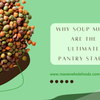Currants vs. Raisins: Understanding the Differences
- by K V
These two dried fruits are currants and raisins, which supply sweetness and texture to many dishes. Other than that, these two fruits have very different flavour profiles from their origin, taste, nutritional value, and uses in the kitchen. This article contrasts currants and raisins so you can make some informed decisions for your recipes and snacking.
What Are Currants?
Currants are small, dried berries that come in a few different varieties:
- Black Currants:
- Origin: Europe and Asia
- Flavour: Tart and intense
- Uses: Jams, jellies, syrups, baking, and savoury dishes
- Red Currants:
- Origin: Europe
- Flavour: Tart and slightly sweet
- Uses: Jams, jellies, salads, and garnishes
- White Currants:
- Origin: Europe
- Flavour: Milder and sweeter than red currants
- Uses: Similar to red currants, but with a more delicate flavour
- Zante Currants (often referred to as "currants" in the culinary world):
- Origin: Greece
- Flavour: Sweet and tangy
- Uses: Baking, desserts, and savoury dishes
What Are Raisins?
Raisins are dried grapes and come in several varieties, depending on the type of grape used:
- Thompson Seedless Raisins:
- Origin: USA (primarily California)
- Flavour: Sweet and chewy
- Uses: Baking, cereals, snacks, and salads
- Golden Raisins:
- Origin: USA and other regions
- Flavour: Sweet and slightly tangy
- Uses: Baking, salads, and savoury dishes
- Sultanas:
- Origin: Turkey, Australia, and USA
- Flavour: Sweet and juicy
- Uses: Baking, cooking, and snacks
- Muscat Raisins:
- Origin: USA (primarily California)
- Flavour: Rich and robust
- Uses: Gourmet recipes, baking, and cheese pairings
Key Differences Between Currants and Raisins
- Origin and Plant Source:
- Currants: Derived from small berries like black, red, and white currants (Ribes species) or Zante currants (dried small grapes).
- Raisins: Made from dried grapes, primarily Thompson seedless, sultanas, golden, and Muscat grapes.
- Size and Appearance:
- Currants: Small, dark, and seedless. Zante currants resemble tiny raisins.
- Raisins: Larger and plumper than currants, with a variety of colours depending on the grape type.
- Flavor Profile:
- Currants: Tangy, tart, and intense. Zante currants are sweeter with a tangy undertone.
- Raisins: Generally sweet, with variations from mildly sweet (Thompson seedless) to richly sweet (Muscat).
- Nutritional Content:
- Currants: High in vitamins C and K, antioxidants, and fibre. They have a lower sugar content than raisins.
- Raisins: Rich in iron, potassium, and antioxidants. Higher in natural sugars and calories compared to currants.
- Culinary Uses:
- Currants: Ideal for tart recipes, jams, jellies, sauces, and certain baked goods. Zante currants are used in scones, fruitcakes, and savoury dishes.
- Raisins: Versatile in baking (cakes, cookies, breads), salads, snacks, cereals, and savoury dishes like rice and couscous.
Choosing Between Currants and Raisins
The choice between currants and raisins depends on the desired flavour, texture, and nutritional benefits for your recipe:
- For Tart and Intense Flavour: Use currants in recipes that benefit from their tangy and robust flavour.
- For Sweetness and Chewiness: Raisins are ideal for adding natural sweetness and a chewy texture to baked goods, cereals, and snacks.
- For Nutritional Benefits: Both are nutritious, but currants offer higher vitamin C and K, while raisins provide more iron and potassium.
Knowing the differences between currants and raisins helps you choose the right ingredient for your creation. Whether it is the tart intensity of the currants or the sweet chew of the raisins, these two dried fruits offer different flavours and health benefits. Mix and use both in your recipes to find out how each enhances your dishes.
- Posted in:
- Antioxidants
- Baking
- Cooking Ingredients
- Culinary Uses
- Currants
- Dried Fruits
- Fr
- Health Benefits
- Minerals
- Nutritional Comparison
- Raisins
- Recipes
- Snacking
- Substitutes
- Sweetness
- Taste
- Texture
- Understanding the Differences
- Varieties
- Vitamins





